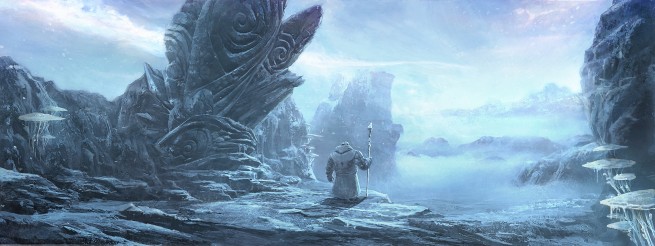Editor’s Note: I’ve already made public my affection for TERA’s real-time action gameplay and museum-worthy art design, but there’s also a third layer to the ambitious game yet to be covered. In the following GamesBeat-exclusive developer diary, David Noonan gives an intimate look into what it takes to craft the story to a 500-hour-long game originating from Korea. I hope you enjoy the read and the exclusive art publisher En Masse Entertainment has provided! ~Sebastian
TERA: A Writer’s Labor of Love
by David Noonan, Writing Team Manager
[vb_gallery id=426658]
Like most gigs in this industry, writing for a massively multiplayer online game (MMO) like TERA is a labor of love. And that timeworn phrase sets the boundaries for my work. When I sit down at my desk each morning, fingers poised over the keyboard, I never really know whether the day will be mostly “labor” or mostly “love.”
Today is mostly labor. I spent my morning going through TERA’s 4,238 quest files, checking recent updates from my counterparts in Korea against bug fixes from our team here in Seattle. I have hundreds of little red icons, and until I click on one, I don’t know what I’m going to get. Maybe it’s just the matter of an extra space at the end of a line, or maybe it’s a completely redesigned quest line.
Click…click…click…the music in my headphones gets louder, and I desperately try to stay focused. The file management required to make a game when the team is divided by an ocean, two languages, and eight time zones is mind-boggling. It’s necessary, but make no mistake: it’s labor.
But there’s lots of love, too. One of my favorite things to do is log onto the quality assurance (QA) server late at night from a darkened room, turn the run speed up on my character, and just explore the world on fast-forward. Over countless builds and iterations, I’ve seen some amazing sights. One day I found a southern ocean autographed by the designer in hundred-mile-long initials. Way to sign your work! (No, it’s not there anymore.) Another time, we had a zone where every non-player character (NPC) had a castanic female body, but the head of another race. That was much creepier than you’d think.
I also love every groaner of a pun in a quest title. I love the character arc for Fraya, a commander you meet about halfway through the game. I love little bits of dialogue in the cinematics, like when Jelena tells the white-haired Elleon: “You look pale—even for you.” I love naming hundreds of swords, axes, and other weapons. I love all those little world-building moments.
Most of all, I love the size of TERA’s “story hole” (the space for narrative in the game). For me, every game is a story-driven RPG. I hold imaginary post-game interviews after I’ve played a console sports game. When I play Risk, I imagine the speech the president gives before he attacks Kamchatka. TERA is a chance to indulge that urge every day when I (and my coffee cup) arrive at En Masse.
For me, TERA will always be that mixture of labor and love. I try to convince myself that the two elements are separate, but every once in a while, I’ll realize that “labor” and “love” are two sides of the same coin. A few weeks ago, my daughter peered over my shoulder at TERA on my laptop. “Daddy, are you working or playing?” she asked.
Darned if I know, kiddo. Darned if I know.
If you’d like to know more about TERA, check out our massive gallery and classes breakdown. You may also be interested in our exclusive Pre-Mortem series.
VentureBeat's mission is to be a digital town square for technical decision-makers to gain knowledge about transformative enterprise technology and transact. Learn More

